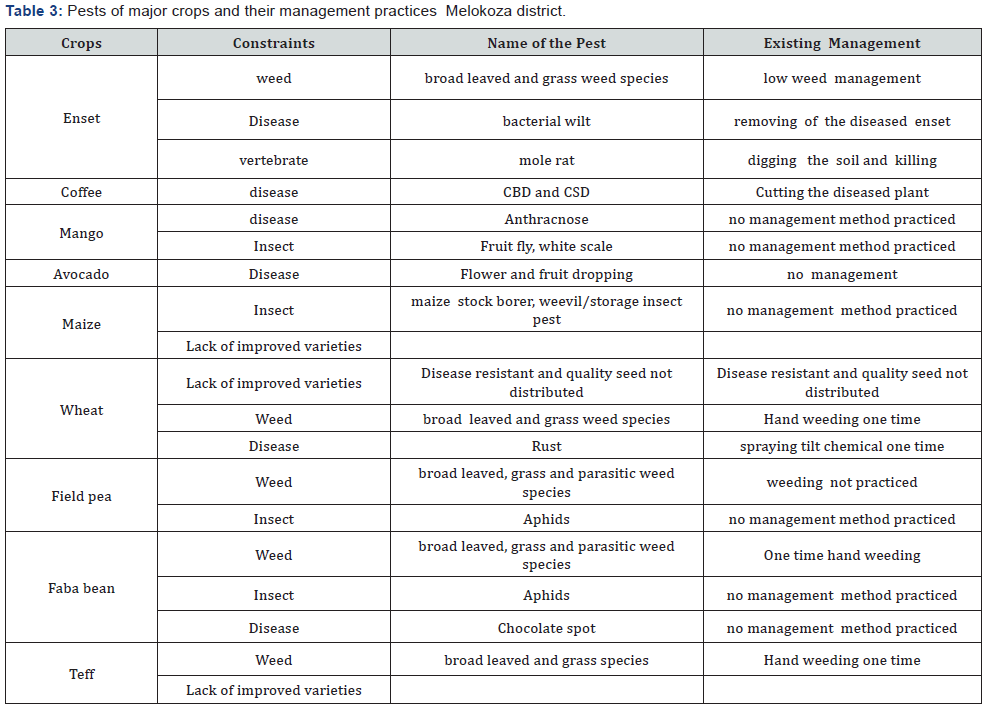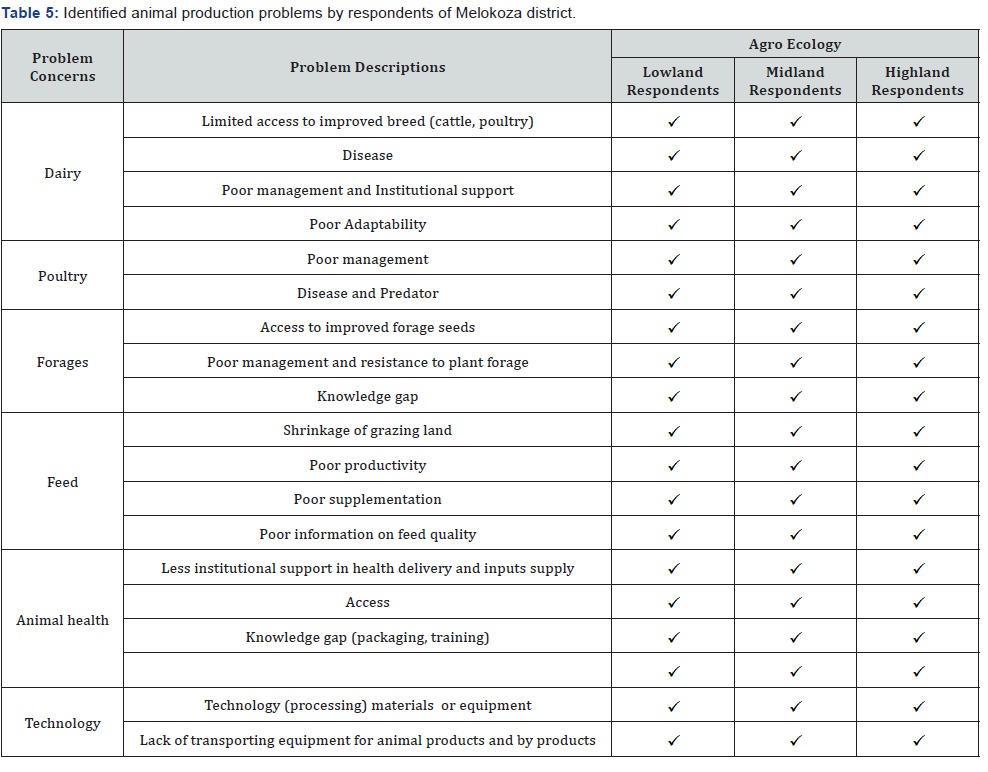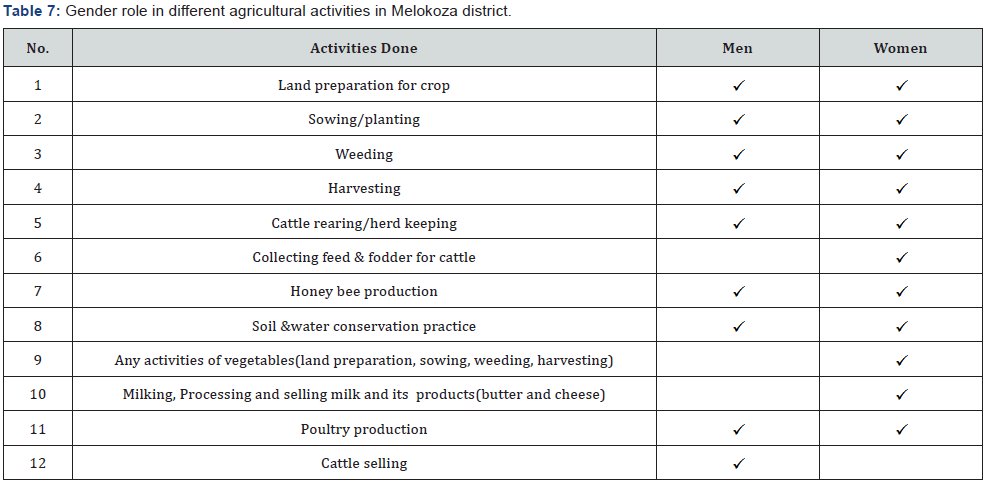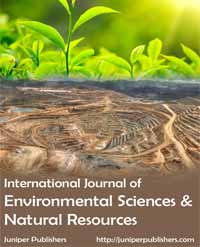Identification and Prioritization of Major Agricultural Production and Productivity Constraints: The Case of Melokoza District, SNNPRs, Ethiopia - Juniper Publishers
Juniper Publishers-Open Access Journal of Environmental Sciences & Natural Resources
Identification and Prioritization of Major Agricultural Production and Productivity Constraints: The Case of Melokoza District, SNNPRs, Ethiopia
Authored by Solomon Yokamo
Abstract
Community level identification of problem (CLIP) survey were conducted in 2016/17 by the objectives of identifying and prioritizing agricultural production and productivity constraints in Melokoza districts for further study. Sample respondents were purposively selected from highland, lowland and midland agro ecology and the group contains youth, women headed and men headed farmers. To collect data focus group discussion (FGD), transact walk, structured observation and key informant interview were undertaken. Data on constraints of agricultural production and productivity were identified and prioritized. Limited access to improved seed, disease and pests outbreak, soil infertility, problems on post harvest handling and quality storage, lack of improved breeds, animal diseases, limited feed supply in quality and quantity, soil erosion, land degradation, clearing of forest for expansion of farm land (deforestation), poor market linkage and poor management , lack of awareness on value addition practices, lack of access to credit are some identified problems of agricultural production and productivity in the district.
Keywords: production constraints; Cropping system; Livelihood system.
Introduction
Agriculture plays an important role in economic growth, enhancing food security, poverty reduction and rural development. It is the main source of income for around 2.5 billion people in the developing world [1]. Small holder agriculture is identified as a vital development tool for achieving Millennium Development Goals, one of which is to halve the people suffering from extreme poverty and hunger by 2015 [2]. However majority of smallholder farmers relies on traditional methods of production and this has lowered the level of productivity. For instance Over 70% of the maize production in the majority of developing countries is from smallholders who use traditional methods of production [3]. These farmers generally obtain very low crop yields because the local varieties used by farmers have low potential yield, most of the maize is grown under rain-fed conditions and irrigation is used only in limited areas, little or no fertilizers are used and pest control is not adequate [3]. Increasing agricultural productivity is critical to meet expected rising demand and, as such, it is instructive to examine recent performance in cases of modern agricultural technologies [4].
Agriculture has been the mainstay of the Ethiopian economy for several centuries. It is still the dominant sector being contributing 42% of the total GDP [5]. According to MoFED [6], the sector employed more than 83% of the population, and was the source of over 90 % of export revenues. It also provides raw materials for more than 70% of the country’s industries. With in the sector, 60% of the agricultural GDP comes from crop production, whereas, 30% and 7% of it is generated from livestock and forestry sectors respectively [3]. Therefore, it is palpable that countries like Ethiopia, which are comparatively endowed with unskilled labor and arable land, would find it relatively easier to follow an agricultural development path. According to World Bank [2], escaping poverty traps in many developing countries such as Ethiopia depends on the growth and development of the agricultural sector.
As part of developing countries in general and Sub-Saharan Africa in particular, Ethiopia is an agrarian country that predominantly relied on subsistence agriculture. According to Ministry of Finance and Economic Development (MoFED [7]), since 1990s as a national strategy, Ethiopia has espoused Agricultural Development-Led Industrialization (ADLI) which predominantly advocates smallholder agriculture and their transformation in to commercial agriculture by employing agricultural technologies. Supporting this, Ministry of Agriculture and Rural Development (MoARD [8]) inferred that majority of the country’s total production is been produced by smallholder farmers; and the sector contributes 90% of the foreign earnings and 70% of the raw materials for industry. Although the sector contributes this much, due to insufficient rate of production and productivity, persistent poverty and drought are actually the main manifestations. To trim down and make poverty history, the country has designed and been implementing different poverty reduction papers including Sustainable Development and Poverty Reduction Program (SDPRP), the Plan for Accelerated and Sustained Development to End Poverty (PASDEP) and Growth and Transformation Plan (GTP).
Despite its paramount importance in the economy and its potential for growth, however, Ethiopia’s agricultural sector has performed poorly in terms of both production and productivity in the last four decades [9,10]. About 40 percent of the population still lives bellow poverty line. Critical food shortage and recurrent famine led to a need for massive food aid and imports [11]. According to Mulat [9], food aid accounted for as much as 10.7 percent of the domestic production during the period 1985 to 1996. The report of Ethiopian Economic Association [12] also stated that in the year 2004, about 7.2 million. Ethiopians have required relief assistance to meet their minimum food requirement. The major reason behind the poor performance of the sector is the backwardness of the technologies used in the production. Moreover, because of the rapid population growth in the country, the rural land holdings are decreasing from time to time. According to Mulat [9], 36 percent of the rural land holdings are less than 0.5 hectare. In addition, the low productivity of the sector makes the farmer subsistent with no or little surplus for investment and input purchase resulting in the vicious circle in the lives of the farmers.
Unfortunately, agricultural production has always been risky, and production risk can be among the highly uncertain and potentially devastating which is a cause for uncertainty in consumption, profit and input choice decisions of farmers [13]. The climate change is the main source of production risks. The accompanied impacts of high temperatures, changed patterns of rainfall and possibly increased frequency of extreme events such as drought and floods, will probably combine to depress yields and increase production risks in many world regions [14]. In addition to weather conditions, pests, diseases, technology and its interaction with farm and management characteristics, genetics, equipment and quality of factor inputs are common sources of production risks. To reduce production risks, at micro level or macro level countries have been following different risk management strategies such as enterprise diversification, crop insurance, contract production, and evaluating new technologies. Due to the underdevelopment of credit and insurance schemes in many developing countries including Ethiopia, farmers usually protect themselves against shocks by adjusting their production and consumption decisions accordingly [15,16].
Similarly South Ethiopia in generally and Melokoza district specifically faces the aforementioned problems. To get baseline data and solve the agricultural production and productivity problems in sustainable way, Arbaminch Agricultural research center in collaboration with Southern agricultural research institute (SARI) and Agricultural growth program two (AGPII) conducts community level problem identification survey to further study in Melokoza district of Gamo Gofa Zone.
Objectives
To identify and prioritize major agricultural production and productivity constraints in the area of crop, animal production, natural resource management and socio economics and marketing aspects in Melokoza district for further study.
Methodology
Description of the Study Area
Melokoza is one of 17 districts in Gamo-Gofa administrative zone which is located in 6o18’117’’ N and 36o37’668’’ E with an altitude range 505-2500m.a.s.l. The district has 39 smallest administrative unit/ kebele (37 rural and 2 peri-urban). According to the Melokoza office of Agriculture, the total population of the district is 152,502. There is bimodal rainfall pattern with average annual rain fall of the district is 1125 mm (minimum 750 mm and maximum 1500 mm) with minimum and maximum temperature of 15.10C and 27.50C, respectively. Maize, and sesame are widely grown in the area. (Melokoza Woreda, office of agriculture, 2015) (Figure 1).

Regarding the land use pattern, total land coverage is 168,180.93ha of which 47,103.897ha is covered by annual crops, 31,884.093ha perennial crops, 6,885ha grazing land, 33,687.15ha natural forest, and others 48620.78 ha. In Melokoza district 26.7% of total farmers are having minimum land holding of less than 0.5 ha and 20.3% of the total farmers are having the land holdings of >2 ha. The soil types of the district classified as clay (15%), Loam(50%) and Sandy loam(35%) across agro ecologies.
Site Selection and Sampling
The survey was conducted in three major agro-ecologies of Melokoza district. Three kebeles from the district representing the highland, midland and low land agro-ecologies selected in collaboration with district administrative council. Purposive sampling were used based on agro ecologies, access to main roads, population, crop and livestock diversity and other cross cutting issues for selection of Kebeles (Table 1).

Data Collection Method
Primary data were collected through Focus Group Discussion (FGD) by organizing the farmers in to three focus groups inclusive of different social groups such as youths, women and men. Each social group separately organized, interviewed and discussed based on checklists prepared in advance to identify constraints, opportunities and priorities of agricultural production and productivity, marketing system and other related issues. Secondary data was collected from written documents of bureau of agriculture of Melokoza district.
Survey Results
Cropping and Farming System of Melokoza District
Crop Production System: Major crops growing both in lowland and midland areas of Melokoza are maize, teff, sorghum, haricot bean, sesame, ground nut, mung bean, tomato, sweet potato, rice, hot pepper, onion, mango, banana, avocado, cassava, coffee, pigeon pea, sun flower, lentil, beet root, carrot and cabbage. Whereas ginger is grown mainly in the lowland areas. Other crops such as taro, enset, corrorima, apple, wheat, barley, pumpkin, faba bean, field pea, garlic and yam are dominantly grown in the highland and mid altitude areas of the district. The district obtains bimodal rain which gives rise to two major cropping seasons (belg and meher). Mono cropping intercropping, relay cropping and rotation. They practice mono cropping in maize, teff and sorghum; relay cropping of maize and haricot bean; inter cropping of maize with haricot bean; and rotation of maize with haricot bean. Maize is commonly grown in the belg season mostly under rain fed condition. They fallow their land as a means of rehabilitation when the soil fertility declines due to intensive cultivation.
Soil Fertility Management: Farmers in all agro ecologies usually apply organic fertilizers like manure and compost; and inorganic fertilizers like urea and DAP to keep their soil fertile. But they do not use the recommended level/rate of either type (organic or inorganic fertilizer). The farmers are worried about decreasing yield of teff and maize through time regardless of their improvement in the use of fertilizer. In such cases, they use crop rotation and fallowing; this decision depends on the capacity of land holding of the household.
Seed and Seed Systems: The sources of seeds in both main cropping seasons (belg and meher) in all agro ecologies are local markets and government. Most of the time, farmers get seeds from the local market and face reduction in yield attributed to lower quality seed. There is no private quality seed supplier so that farmers mostly use local varieties and hence their production as well as productivity is low. Moreover, they get improved seeds only for maize and teff, apart from these, they are using land races. The sole source of improved seed for maize and teff is the office of agriculture. The extension agents that are assigned to give technical support for the farmers are not accomplishing their deeds to the level expected from them and hence, the farmers are still producing in traditional way, which subjected them to lower productivity.
Method of Plowing and Frequency of Tillage: The farmers usually till their land using oxen in mid altitude and lowland parts of Melokoza, the frequency of tillage varies with crop type. They plough three times for maize and sorghum, one to two times for haricot bean and teff. But land preparation in the highland parts is dominantly carried out by people, they till the land manually (through digging). This in turn increases the labor cost and consequently reducing productivity (Table 2).

Farmers in the all agro ecologies of Melokoza mainly pra mono cropping intercropping, relay cropping and rotation. They practice mono cropping in maize, teff and sorghum; relay cropping of maize and haricot bean; inter cropping of maize with haricot bean; and rotation of maize with haricot bean. Maize is commonly grown in the belg season mostly under rain fed condition. They fallow their land as a means of rehabilitation when the soil fertility declines due to intensive cultivation.
Seed Rate and Method of Planting: The farmers in all agro ecologies are not well accustomed with row planting for many crops; they still broadcast the seeds of all crops other than maize. They are not aware of the advantages of row planting against broadcasting, there still remains extension gap. Consequently, the farmers do not use the recommended rate of seed and fertilizer.
Pest Management Practices: Farmers in all agro ecologies are facing different pest problems that resulted in significant amount of yield loss. Some of them are diseases like bacterial wilt and stem rust; insect pests like maize stalk borer and weeds. Moreover, they don’t have improved and well established way of controlling pests (Table 3).

Harvesting and Post-Harvest Handling Techniques: The harvesting practice of farmers in all agro ecologies are similar; they usually harvest cereal crops manually using sickles and they use different digging materials for root and tuber crops. They transport their crops from field to barns through carts and pack animals; in several cases through carrying on their own head and back. Threshing is done manually by hand and threshed grains are stored in traditional sacks (Table 4).

Animal Production System
Types of Animal: The most common types of animals kept across all agro ecologies of Melokoza are cattle, donkey, poultry and honeybees. Sheep are mainly raised in mid altitude and highland parts whereas goats are kept in the lowlands and mid altitude areas; while horses are common in highlands.
Animal Feed Source: The potential livestock feed sources across all agro ecologies are grazing lands and crop residues. Cattle and goats in the lowlands and partly in mid altitude areas are allowed to graze/browse freely on communal lands without restriction. Whereas in the high lands and partly mid altitude areas, the animals are not allowed to graze freely; the farmers have their own private grazing land on which they tether and graze their animals. Some farmers also have the practice of providing a little amount of grain residuals as supplementary feeding. But in the lowlands, there is no such practices.
a) Dry Season Feed Sources: The major livestock feed sources in all agro ecologies during dry season are crop residuals and grazing lands. Maize and Sorghum crop residuals are the prominent ones. Goats solely depend on browse. Most farmers do not have awareness on improved feed conservation and preservation techniques such as silage and hay. Yet some farmers supplement dairy and fattening animals with certain amount of grain residuals and silage.
b) Wet Season Feed Sources: The farmers across all agro ecologies do not have problems of livestock feed shortage in the wet season. They graze their animals on private or communal grazing lands, they provide their animals with different species of grasses, legumes and green fodder (Table 5).

Natural Resource Management
Soil and Water Conservation: Regardless of the suitability of the soil for agricultural activity in Melokoza district, absence of /limited soil and water conservation measures (physical, biological), unwise farming practices and little practice of degraded land rehabilitation and lack of moisture conservation practices made the soil susceptible to degradation. In addition, the farmers dwelling in the highland and midland of the district plow steep slope which enhances soil erosion. Moreover, they plow their land along the slope (vertically) for tuber crops (especially for sweet potato) with a belief of getting higher yield. The development agents are trying to aware the farmers about the negative impact of such method of plowing yet they are not successful since then.
Forestry and Agro Forestry Species: Melokoza is rich in indigenous and exotic species of plants including multipurpose trees and shrubs such as Cordia africana, Hagenian abyssinica, Cajanus cajan, susbania and luceania. These species are distributed throughout all agro ecologies in the district. However, deforestation of natural forest for expansion of agricultural land, fire wood, wood products, timber and household equipment are the major problem threatening the forest coverage of the district. The farmers don’t have awareness on the advantages of agro forestry practices as compared to mono cropping; they don’t aware on spacing and agronomic practices of agro forestry plants. In addition to this, absence of nursery sites focusing on multiplication of multipurpose trees and shrubs magnifies its significant negative impact on the adoption of agro forestry practices in the area.
Small Scale Irrigation Program: Melokoza district is endowed with many rivers that are potentially good for small scale irrigation. However, undulating and rugged topography of the area made the rivers hardly accessible for surface irrigation. In some of the small scale irrigation schemes, problems linked with design of canals that bring water from the source (rivers) are lowering their performance and coverage. In all the agro ecologies, there is a problem of irrigation utilization which is resulted in unnecessary interest conflict and wastage of water.
Livelihood Systems and Household Economy
Socio-Cultural Settings and Resource Endowments: The farmers in all agro ecologies are included in several social organizations such as Idir and ekub; and village elderly (shimigilina) system in the area. Idir organizations are set for the time of emergency like funeral and sudden social mishap. The farmers usually save their money in the form of ekub and buy some essential materials that they use in common during different social occasions. Such cooperation strengthens their fellowship and sustains the good norms and rules of the society; while attacking and preventing other intruding i ill cultures and behaviors.
Major Income Sources: The primary source of income to the farmers in Melokoza district are crops followed by livestock and private forest (sale of trees). Nonagricultural activities like trade, wage and remittance are other sources of income. But the income they earn is too small to cover the cost of different agricultural inputs (Table 6).

Input and Credit Supply: Farmers obtain fertilizer and improved seeds from Melokoza district office of agriculture. There is no any private improved quality seeds supplier in the area. The farmers access credit from private lenders and these lenders collect money with unreasonable high interest exploiting the farmers. This in turn will affect agricultural production and productivity.
Gender Role and Decision Making: Most agricultural activities among farmers of all agro ecologies in Melokoza are held by both genders. Some activities such as cultivation of vegetables; processing and selling of milk and milk products are carried out by women (regarded as women’s activities) while planting of perennial trees and crops like coffee and enset; land preparation with spade; cutting trees; selling animals and beekeeping are regarded as men’s career. However, decision making on resource use is made through discussion and mutual understanding. But the past experience of male dominance is decreasing gradually. But in some households, the women are oppressed and the husband decides whatever he wants without the consent of his wife. Chicken, shoats, horticultural crops, and milk and milk products are controlled by women and they sell these commodities after consulting their husband (Table 7).

Nutrition: Crops that are dominant and most preferred sources of nutrition in all agro ecologies of Melokoza are maize, sorghum, wheat, barley, avocado, sesame, teff and banana; and livestock products like milk, meat, egg, butter, cheese, yoghurt and honey. They most commonly consume kitta (which is prepared from flour of maize, sorghum, barley and teff) with cabbage; kitta bread orenjera with horticultural crops; kitta, bread or enjera with animal products (milk, meat, egg, yoghurts, cheese, honey); kolo (prepared from maize, barley, chick pea, field pea, faba bean, etc) and enset products (kocho and bulla) with cabbage.
Climate Smart Agriculture: The farmers told that large trees that are found in their farms play a good role in keeping the soil from erosion and refreshing the air in the compound. They do several practices to enhance productivity such as shifting cultivation, organic manure application and crop rotation those can be regarded as climate change mitigation strategies. Farmers found in the highlands and mid altitude areas often grow woody trees inside enset and coffee fields as agro forestry practice. The trees provide shade for the crops and mulch to the soil. The coffee and enset cultivation is purely organic and the farmers use farmyard manure, twigs and leaves of shade trees and compost. This enables the practice of climate smart agriculture. In addition to this, the massive campaign that is being carried out in February and March is facilitating the construction of different soil and water conservation structures that stabilize the soil and reduces soil erosion.
Conclusion and Recommendation
Agriculture plays an important role in economic growth, enhancing food security, poverty reduction and rural development. It is the main source of income for around 2.5 billion people in the developing world. Agriculture is still the dominant sector being contributing 42% of the total GDP. The sector employed more than 83% of the population, and was the source of over 90 % of export revenues. It also provides raw materials for more than 70% of the country’s industries. With in the sector, 60% of the agricultural GDP comes from crop production, whereas, 30% and 7% of it is generated from livestock and forestry sectors respectively. Unfortunately, agricultural production has always been risky, and production risk can be among the highly uncertain and potentially devastating which is a cause for uncertainty in consumption, profit and input choice decisions of farmers.
The climate change is the main source of production risks. The accompanied impacts of high temperatures, changed patterns of rainfall and possibly increased frequency of extreme events such as drought and floods, will probably combine to depress yields and increase production risks. Community level identification of problems and plannening for further study were conducted in Melokoza district at three different agro ecology (Highland, midland and lowland) and the main agricultural production and productivity constraints were identified and prioritized for further study. Limited access to improved seed, lack of awareness on different agronomic practices, soil infertility, disease and pest, lack of quality storage, lack of improved breeds, animal disease, lack of animal feeds in quality and quantity, poor marketing linkage, gaps on value addition practices, lack of access to credit, deforestation and soil erosion were some identified problems in the district. For the aforementioned problems:
a) Development of high yielding, disease and pest resistant improved varieties.
b) Creating awareness on general agronomic practices.
c) Giving great attention on post harvest handling.
d) Development of improved breeds that was productive and disease resistant.
e) Working on the quality and quantity of animal feeds.
f) Constructing irrigation canals.
g) Creating awareness on physical and biological soil and water conservation methods
h) Identify and map the various business services provider and chain supporters.
i) Participatory pre extension demonstration and popularizing recommended/different improved agricultural technologies (Crop, livestock and Natural resource) with its full package on farm land to enhance farmer’s awareness are the main thematic areas in which intervention should needed.
To know more about Juniper Publishers please click on: https://juniperpublishers.com/manuscript-guidelines.php
For more articles in Open Access Journal of Environmental Sciences & Natural Resources please click on: https://juniperpublishers.com/ijesnr/index.php




Comments
Post a Comment